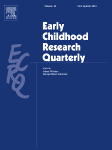 From the abstract: "Preschool teachers were randomly assigned to participate in two professional development interventions over two phases, both designed to improve their interactions with children: the NCRECE college course (N = 169) and MyTeachingPartner video-based coaching (N = 202). Using Berkel et al.’s (2011) integrated model of intervention implementation, we examined whether the association between teachers' perception of intervention quality and their improvement in instructional interactions was mediated by their responsiveness to the intervention. We tested the model across both professional development opportunities. Findings indicated that preschool teachers were more responsive to the intervention when they reported higher perceived quality for both the course and coaching. The association between perceived intervention quality and improvement in instructional teaching practice was mediated by teacher responsiveness in the coaching intervention only. Findings indicate that professional development implementers need to focus on how participants perceive interventions and what exactly the key aspects within the interventions are, given the importance of their perspective to what they actually do within interventions that lead to change."
From the abstract: "Preschool teachers were randomly assigned to participate in two professional development interventions over two phases, both designed to improve their interactions with children: the NCRECE college course (N = 169) and MyTeachingPartner video-based coaching (N = 202). Using Berkel et al.’s (2011) integrated model of intervention implementation, we examined whether the association between teachers' perception of intervention quality and their improvement in instructional interactions was mediated by their responsiveness to the intervention. We tested the model across both professional development opportunities. Findings indicated that preschool teachers were more responsive to the intervention when they reported higher perceived quality for both the course and coaching. The association between perceived intervention quality and improvement in instructional teaching practice was mediated by teacher responsiveness in the coaching intervention only. Findings indicate that professional development implementers need to focus on how participants perceive interventions and what exactly the key aspects within the interventions are, given the importance of their perspective to what they actually do within interventions that lead to change."
2016
LoCasale-Crouch, J., DeCoster, J., Cabell, S. Q., Pianta, R. C., Hamre, B. K., Downer, J. T., . . . Roberts, A. (2016). Unpacking intervention effects: Teacher responsiveness as a mediator of perceived intervention quality and change in teaching practice. Early Childhood Research Quarterly, 36, 201-209.
10.1016/j.ecresq.2015.12.022
